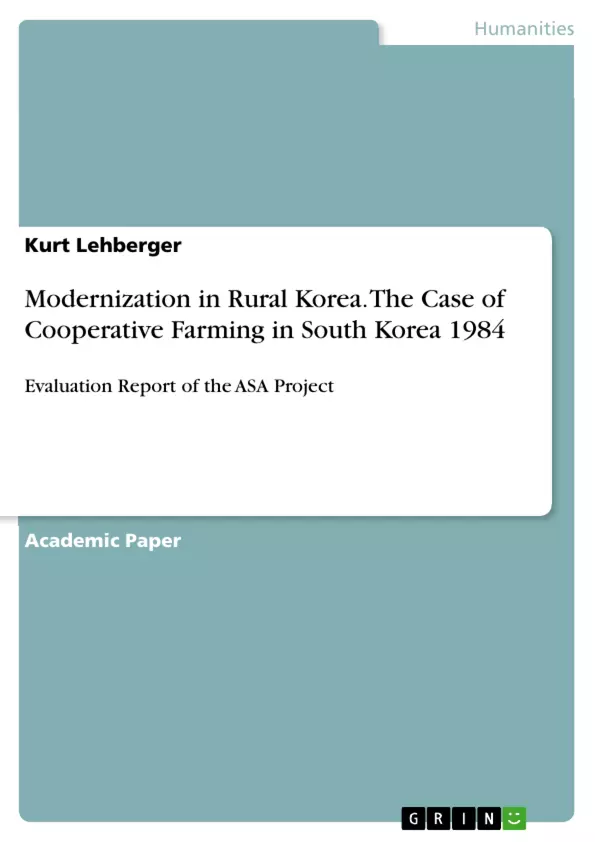The study shows the socio-economic development in rural regions in South Korea. The agricultural structure and the agricultural constitution are presented and historical peculiarities are shown. The government program Saemaul Undong - the new village movement - is described and its effects critically questioned. The credit unions and other cooperatives are presented and their benefits for the development of the rural population are evaluated.
Inhaltsverzeichnis (Table of Contents)
- The role of agriculture in export-oriented industrialization.
- Agricultural Constitution
- Agricultural Structure
- Labor force in the agricultural sector
- Planting Structure
- Livestock
- Budgetary balance of agricultural holdings.
- Agricultural prices and agricultural price policy.
- Debt and migration.
- The "New Village Movement".
- Credit cooperatives.
- Pulmuwon - a country cooperative.
- Kuokmal - a country cooperative.
Zielsetzung und Themenschwerpunkte (Objectives and Key Themes)
This work, the result of the ASA project "Land Cooperatives in South Korea," examines the modernization of rural Korea through the lens of cooperative farming. The study, conducted between December 1984 and February 1985, provides insights into the agricultural sector's challenges and opportunities in South Korea during this period.
- The role of agriculture in South Korea's export-oriented industrialization.
- The structure and challenges of the agricultural sector, including labor force, planting structure, livestock, and budgetary balance.
- The impact of government policies, particularly the "New Village Movement," on rural development.
- The role of credit cooperatives and their significance in rural social development.
- The case studies of two land cooperatives, Pulmuwon and Kuokmal, highlight the benefits and challenges of cooperative farming.
Zusammenfassung der Kapitel (Chapter Summaries)
The report begins by examining the role of agriculture in South Korea's export-oriented industrialization strategy. It then delves into the agricultural constitution and structure, analyzing the labor force, planting structure, and livestock sector. Chapter 4 explores the budgetary balance of agricultural holdings, followed by an in-depth examination of agricultural prices and the government's price policy.
Subsequent chapters focus on the impact of debt and migration on rural communities, the government's "New Village Movement," and the role of credit cooperatives in social development. The report concludes with case studies of two land cooperatives, Pulmuwon and Kuokmal, providing insights into the benefits and challenges of cooperative farming in South Korea.
Schlüsselwörter (Keywords)
This report examines the modernization of rural Korea, focusing on agricultural structure, government policies, credit cooperatives, and cooperative farming. Key themes include export-oriented industrialization, agricultural development, rural social development, and the role of the government in shaping the future of agriculture in South Korea. The report also delves into the case studies of two land cooperatives, Pulmuwon and Kuokmal, highlighting the experiences and challenges of cooperative farming in the Korean context.
- Arbeit zitieren
- Kurt Lehberger (Autor:in), 1984, Modernization in Rural Korea. The Case of Cooperative Farming in South Korea 1984, München, GRIN Verlag, https://www.hausarbeiten.de/document/425817


